гигиена.pptx
- Количество слайдов: 14
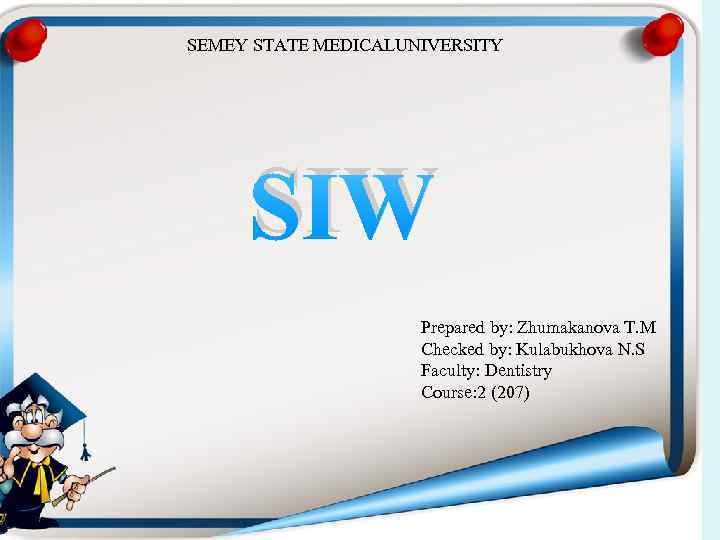
SEMEY STATE MEDICALUNIVERSITY SIW Prepared by: Zhumakanova T. M Checked by: Kulabukhova N. S Faculty: Dentistry Course: 2 (207)
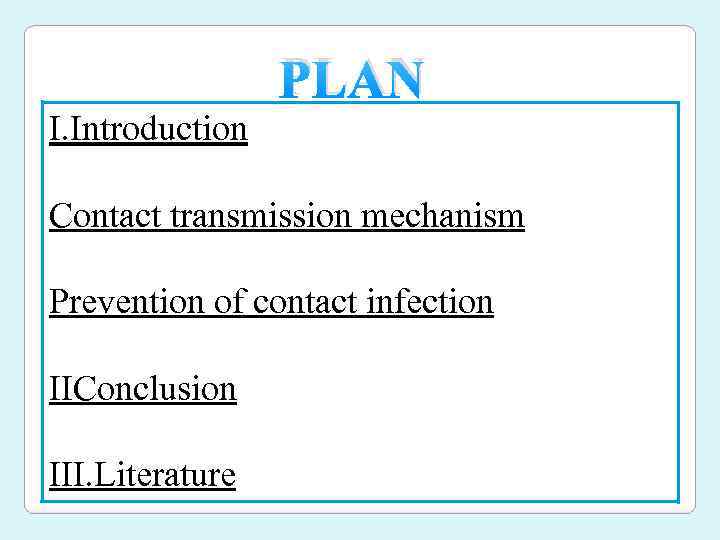
PLAN I. Introduction Contact transmission mechanism Prevention of contact infection IIConclusion III. Literature

Introduction
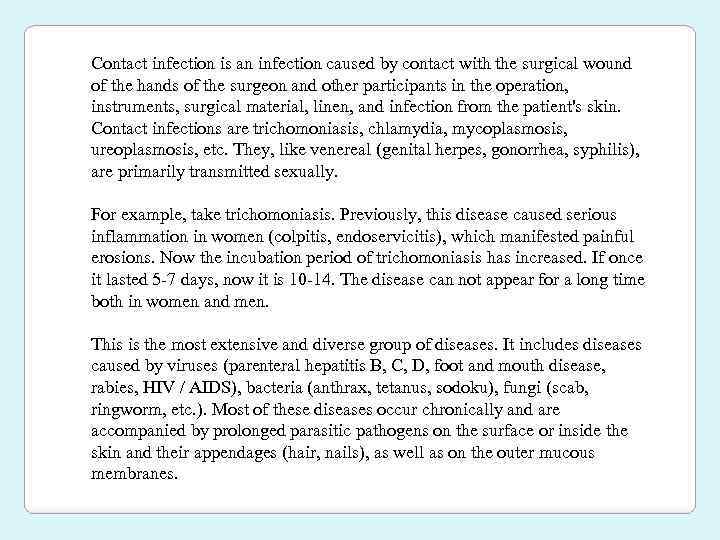
Contact infection is an infection caused by contact with the surgical wound of the hands of the surgeon and other participants in the operation, instruments, surgical material, linen, and infection from the patient's skin. Contact infections are trichomoniasis, chlamydia, mycoplasmosis, ureoplasmosis, etc. They, like venereal (genital herpes, gonorrhea, syphilis), are primarily transmitted sexually. For example, take trichomoniasis. Previously, this disease caused serious inflammation in women (colpitis, endoservicitis), which manifested painful erosions. Now the incubation period of trichomoniasis has increased. If once it lasted 5 -7 days, now it is 10 -14. The disease can not appear for a long time both in women and men. This is the most extensive and diverse group of diseases. It includes diseases caused by viruses (parenteral hepatitis B, C, D, foot and mouth disease, rabies, HIV / AIDS), bacteria (anthrax, tetanus, sodoku), fungi (scab, ringworm, etc. ). Most of these diseases occur chronically and are accompanied by prolonged parasitic pathogens on the surface or inside the skin and their appendages (hair, nails), as well as on the outer mucous membranes.
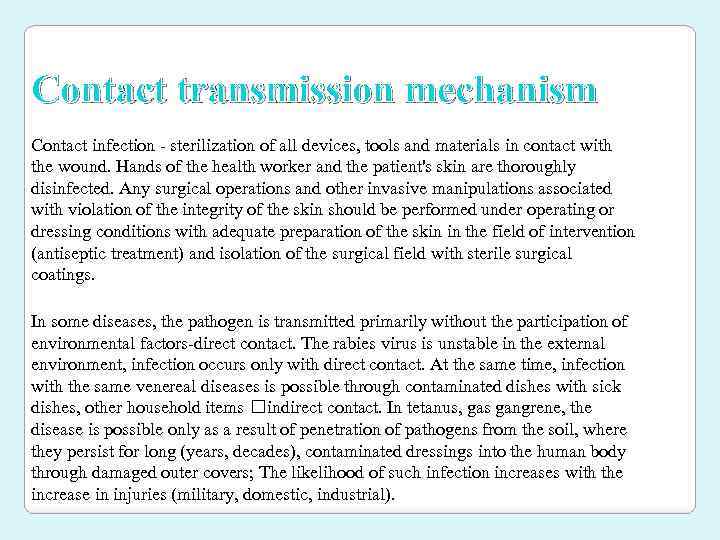
Contact transmission mechanism Contact infection - sterilization of all devices, tools and materials in contact with the wound. Hands of the health worker and the patient's skin are thoroughly disinfected. Any surgical operations and other invasive manipulations associated with violation of the integrity of the skin should be performed under operating or dressing conditions with adequate preparation of the skin in the field of intervention (antiseptic treatment) and isolation of the surgical field with sterile surgical coatings. In some diseases, the pathogen is transmitted primarily without the participation of environmental factors-direct contact. The rabies virus is unstable in the external environment, infection occurs only with direct contact. At the same time, infection with the same venereal diseases is possible through contaminated dishes with sick dishes, other household items indirect contact. In tetanus, gas gangrene, the disease is possible only as a result of penetration of pathogens from the soil, where they persist for long (years, decades), contaminated dressings into the human body through damaged outer covers; The likelihood of such infection increases with the increase in injuries (military, domestic, industrial).
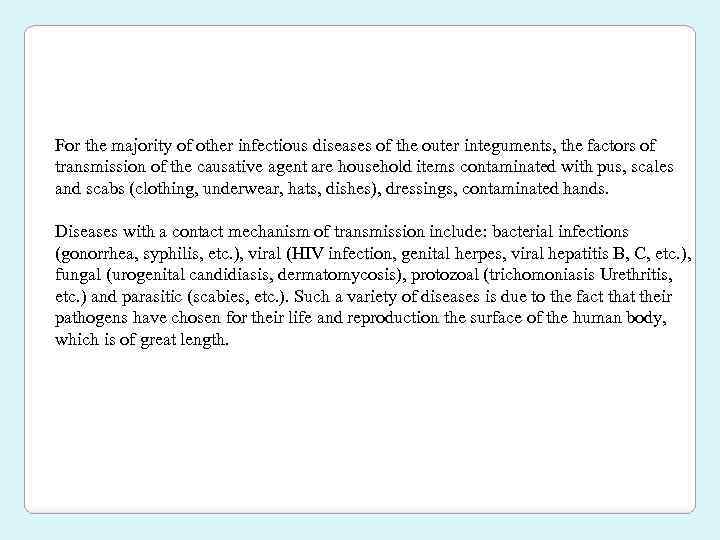
For the majority of other infectious diseases of the outer integuments, the factors of transmission of the causative agent are household items contaminated with pus, scales and scabs (clothing, underwear, hats, dishes), dressings, contaminated hands. Diseases with a contact mechanism of transmission include: bacterial infections (gonorrhea, syphilis, etc. ), viral (HIV infection, genital herpes, viral hepatitis B, C, etc. ), fungal (urogenital candidiasis, dermatomycosis), protozoal (trichomoniasis Urethritis, etc. ) and parasitic (scabies, etc. ). Such a variety of diseases is due to the fact that their pathogens have chosen for their life and reproduction the surface of the human body, which is of great length.
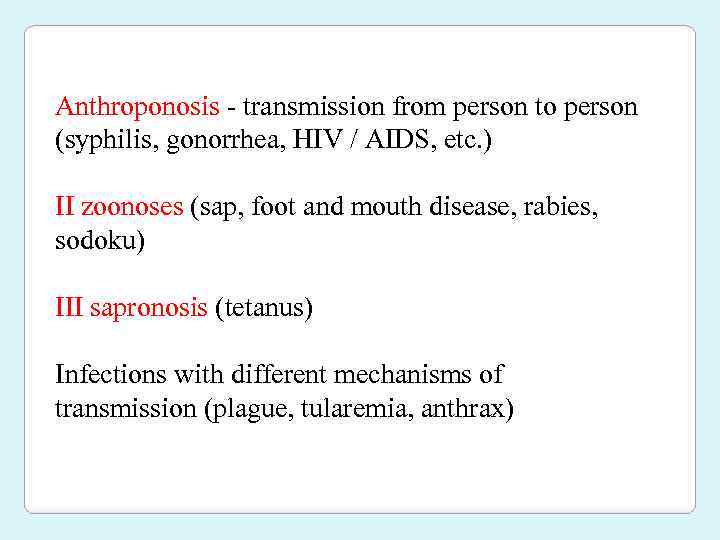
Аnthroponosis - transmission from person to person (syphilis, gonorrhea, HIV / AIDS, etc. ) ІІ zoonoses (sap, foot and mouth disease, rabies, sodoku) ІІІ sapronosis (tetanus) Infections with different mechanisms of transmission (plague, tularemia, anthrax)
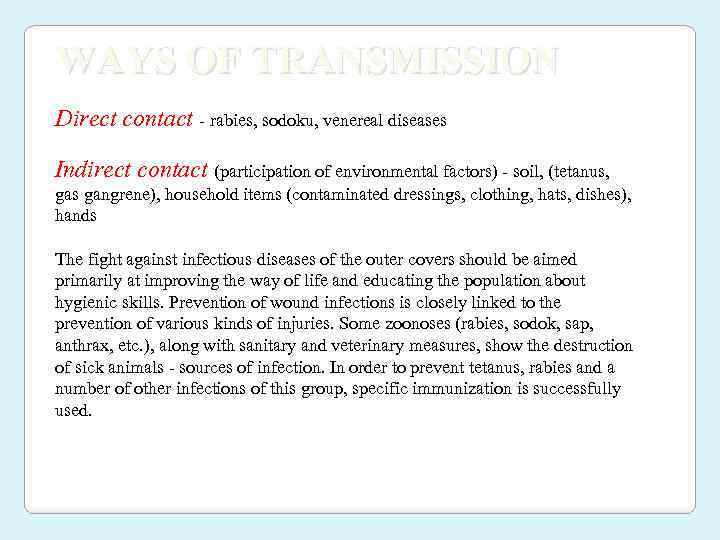
WAYS OF TRANSMISSION Direct contact - rabies, sodoku, venereal diseases Indirect contact (participation of environmental factors) - soil, (tetanus, gas gangrene), household items (contaminated dressings, clothing, hats, dishes), hands The fight against infectious diseases of the outer covers should be aimed primarily at improving the way of life and educating the population about hygienic skills. Prevention of wound infections is closely linked to the prevention of various kinds of injuries. Some zoonoses (rabies, sodok, sap, anthrax, etc. ), along with sanitary and veterinary measures, show the destruction of sick animals - sources of infection. In order to prevent tetanus, rabies and a number of other infections of this group, specific immunization is successfully used.
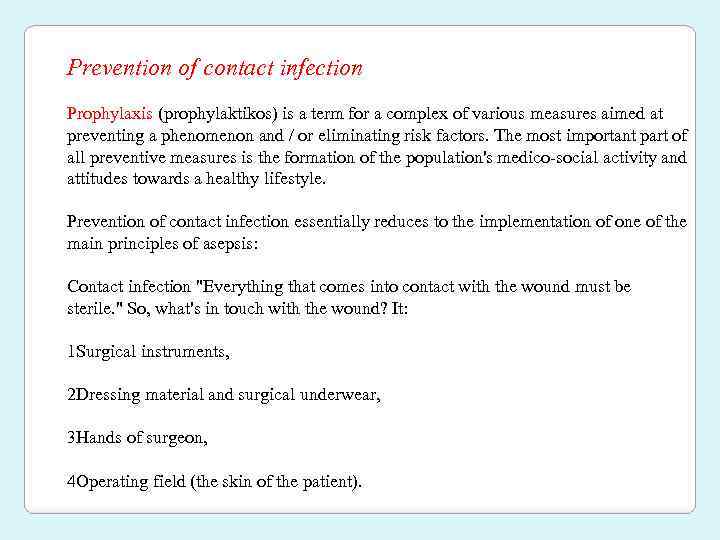
Prevention of contact infection Prophylaxis (prophylaktikos) is a term for a complex of various measures aimed at preventing a phenomenon and / or eliminating risk factors. The most important part of all preventive measures is the formation of the population's medico-social activity and attitudes towards a healthy lifestyle. Prevention of contact infection essentially reduces to the implementation of one of the main principles of asepsis: Contact infection "Everything that comes into contact with the wound must be sterile. " So, what's in touch with the wound? It: 1 Surgical instruments, 2 Dressing material and surgical underwear, 3 Hands of surgeon, 4 Operating field (the skin of the patient).
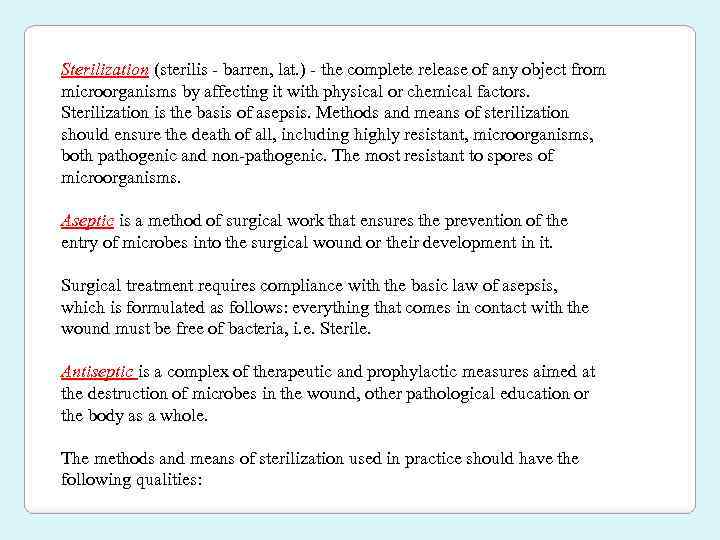
Sterilization (sterilis - barren, lat. ) - the complete release of any object from microorganisms by affecting it with physical or chemical factors. Sterilization is the basis of asepsis. Methods and means of sterilization should ensure the death of all, including highly resistant, microorganisms, both pathogenic and non-pathogenic. The most resistant to spores of microorganisms. Aseptic is a method of surgical work that ensures the prevention of the entry of microbes into the surgical wound or their development in it. Surgical treatment requires compliance with the basic law of asepsis, which is formulated as follows: everything that comes in contact with the wound must be free of bacteria, i. e. Sterile. Antiseptic is a complex of therapeutic and prophylactic measures aimed at the destruction of microbes in the wound, other pathological education or the body as a whole. The methods and means of sterilization used in practice should have the following qualities:

Be effective in terms of bactericidal and sporicidal activity, Be safe for patients and medical staff, Do not degrade the working properties of tools. In modern aseptics, physical and chemical methods of sterilization are used. Physical methods include: thermal methods - burning and boiling, sterilization with steam under pressure (autoclaving), sterilization with hot air (dry heat), and also radiation sterilization. The chemical methods include the gas method and sterilization with solutions of chemical preparations. The duration of treatment for contact infections depends on how much the disease is started. Minimum - three to four months, sometimes - up to six months. From the infection must necessarily get rid of, as an untreated disease sooner or later will again manifest itself in a more serious or even chronic form. As a result, infertility, cysts of the appendages, erosion of the cervix and uterine myomas can develop in women, prostatitis in men. Usually chronic diseases (in men - urethritis, prostatitis, in women - adnexitis, colpitis, metroendometritis) lead to an increase in lymph nodes.
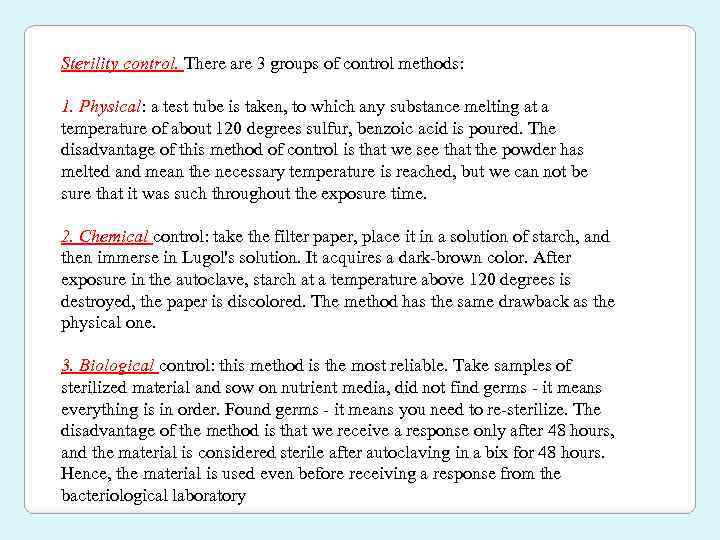
Sterility control. There are 3 groups of control methods: 1. Physical: a test tube is taken, to which any substance melting at a temperature of about 120 degrees sulfur, benzoic acid is poured. The disadvantage of this method of control is that we see that the powder has melted and mean the necessary temperature is reached, but we can not be sure that it was such throughout the exposure time. 2. Chemical control: take the filter paper, place it in a solution of starch, and then immerse in Lugol's solution. It acquires a dark-brown color. After exposure in the autoclave, starch at a temperature above 120 degrees is destroyed, the paper is discolored. The method has the same drawback as the physical one. 3. Biological control: this method is the most reliable. Take samples of sterilized material and sow on nutrient media, did not find germs - it means everything is in order. Found germs - it means you need to re-sterilize. The disadvantage of the method is that we receive a response only after 48 hours, and the material is considered sterile after autoclaving in a bix for 48 hours. Hence, the material is used even before receiving a response from the bacteriological laboratory
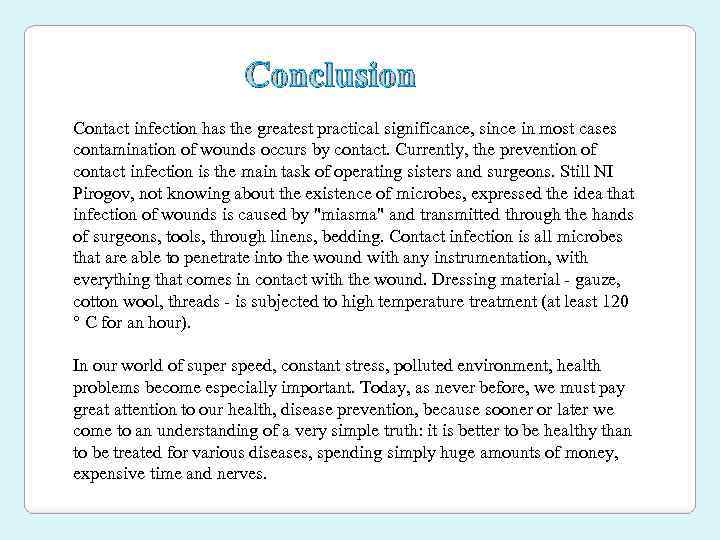
Conclusion Contact infection has the greatest practical significance, since in most cases contamination of wounds occurs by contact. Currently, the prevention of contact infection is the main task of operating sisters and surgeons. Still NI Pirogov, not knowing about the existence of microbes, expressed the idea that infection of wounds is caused by "miasma" and transmitted through the hands of surgeons, tools, through linens, bedding. Contact infection is all microbes that are able to penetrate into the wound with any instrumentation, with everything that comes in contact with the wound. Dressing material - gauze, cotton wool, threads - is subjected to high temperature treatment (at least 120 ° C for an hour). In our world of super speed, constant stress, polluted environment, health problems become especially important. Today, as never before, we must pay great attention to our health, disease prevention, because sooner or later we come to an understanding of a very simple truth: it is better to be healthy than to be treated for various diseases, spending simply huge amounts of money, expensive time and nerves.
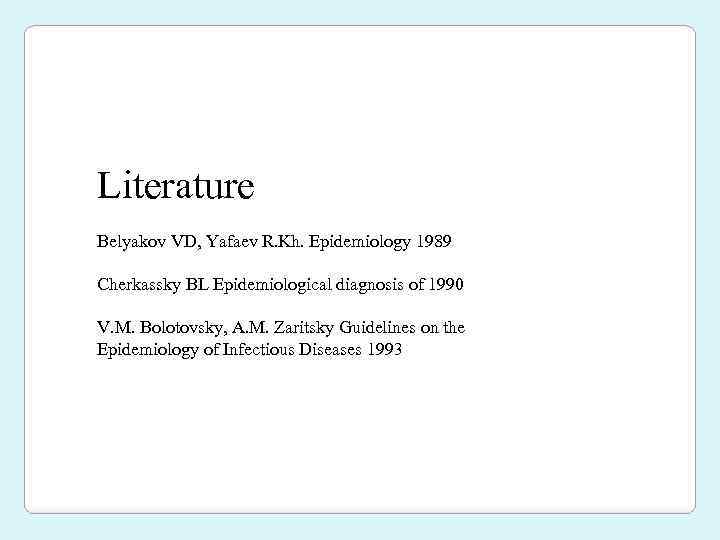
Literature Belyakov VD, Yafaev R. Kh. Epidemiology 1989 Cherkassky BL Epidemiological diagnosis of 1990 V. M. Bolotovsky, A. M. Zaritsky Guidelines on the Epidemiology of Infectious Diseases 1993
гигиена.pptx